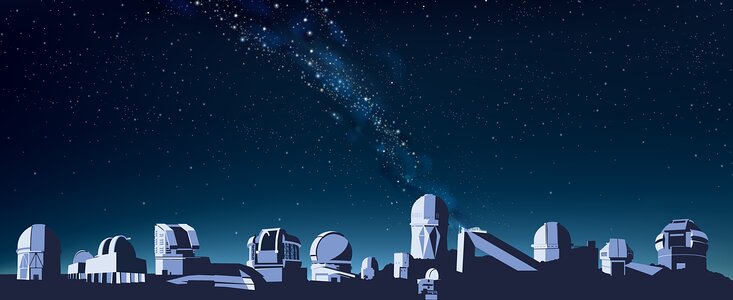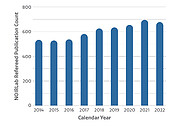NSF’s NOIRLab Again Achieves World-Class Productivity
NOIRLab’s world-class telescopes and data archive reach new publication milestone in 2022 and continue upward trend in 2023
25 August 2023
The number of publications in peer-reviewed journals is among the most important productivity metrics in astronomy, astrophysics, and all of science. NSF’s NOIRLab, which encompasses many of the world’s most powerful and productive telescopes, continues to provide exceptional service to the international astronomical community, leading to impressive representation in peer-reviewed publications.
Since 2014 the observatories comprising NOIRLab have seen a steady increase in total publications, from 535 refereed publications in the 2014 calendar year [1] to 703 refereed publications in 2022. This trend positions NOIRLab in the upper echelon of world-class observatories, alongside the European Southern Observatory and the Hubble Space Telescope.
Breaking this trend down by Program, the International Gemini Observatory recorded 262 refereed publications in 2022, comprising 170 refereed publications from the Gemini North telescope and 132 from the Gemini South telescope (some publications used both telescopes). Among these publications were highly impactful discoveries, such as Gemini North’s discovering the closest black hole to Earth and Gemini South’s making rapid-response observations of a record-breaking gamma-ray burst. These observations were made under Gemini’s Director’s Discretionary queue programming and Target of Opportunity observing mode, respectively.
NOIRLab’s Community Science Data Center (CSDC) contributed to 191 publications in 2022. These papers are based in whole or in part on archival data made available through CSDC’s data products and services, such as NOIRLab’s Astro Data Archive (formerly the NOAO Science Archive) and NOIRLab’s Astro Data Lab. In 2022, CSDC data were fundamental to the success of NOIRLab’s Backyard Worlds: Planet 9 citizen-science project. In the coming years, CSDC will open the doors to more profound discoveries with data from DOE’s Lawrence Berkeley National Laboratory's Dark Energy Spectroscopic Instrument (DESI), which has already cataloged more than 26 million astronomical objects and is adding more than a million per month. CSDC’s Astro Data Lab has also begun to serve high-level science data products from Gemini Observatory’s Large and Long Programs, with additional data sets forthcoming.
Contributing to the largest number of total refereed publications in 2022, with 466 (66%), are NOIRLab’s mid-scale observatories (MSO). This metric includes telescopes at Kitt Peak National Observatory (KPNO) and Cerro Tololo Inter-American Observatory (CTIO, both Programs of NSF’s NOIRLab. A major fraction of these, with 268 publications (58%), resulted from observations made with the Víctor M. Blanco 4-meter Telescope at CTIO. Additionally, the 4.1-meter Southern Astrophysical Research (SOAR) telescope at CTIO contributed to 92 papers, the Nicholas U. Mayall 4-meter telescope at KPNO contributed to 80 papers and the WIYN 3.5-meter telescope at KPNO contributed to 38 papers. MSO highlights include SOAR’s helping astronomers confirm the existence of only the second-known Earth Trojan asteroid, WIYN 3.5 observing the lowest-density gas giant ever detected around a red dwarf, and Blanco’s discovery of the largest potentially hazardous asteroid detected in eight years.
Only publications from NOIRLab-operated telescopes are included [2]. In 2022 NOIRLab staff astronomers contributed 315 additional refereed publications using other telescopes and data.
These numbers highlight NOIRLab’s world-class productivity and dedication to enabling and sharing breakthrough discoveries in astronomy and astrophysics with state-of-the-art ground-based observatories, data products, and services for a diverse and inclusive community.
More information
[1] Metrics here are reported for the calendar year rather than fiscal year.
[2] NOIRLab-operated telescopes: Gemini North Telescope, Gemini South Telescope, SOAR Telescope, Víctor M. Blanco 4-meter Telescope, Nicholas U. Mayall 4-meter Telescope, WIYN 3.5-meter Telescope.
NSF’s NOIRLab (National Optical-Infrared Astronomy Research Laboratory), the US center for ground-based optical-infrared astronomy, operates the International Gemini Observatory (a facility of NSF, NRC–Canada, ANID–Chile, MCTIC–Brazil, MINCyT–Argentina, and KASI–Republic of Korea), Kitt Peak National Observatory (KPNO), Cerro Tololo Inter-American Observatory (CTIO), the Community Science and Data Center (CSDC), and Vera C. Rubin Observatory (operated in cooperation with the Department of Energy’s SLAC National Accelerator Laboratory). It is managed by the Association of Universities for Research in Astronomy (AURA) under a cooperative agreement with NSF and is headquartered in Tucson, Arizona. The astronomical community is honored to have the opportunity to conduct astronomical research on Iolkam Du’ag (Kitt Peak) in Arizona, on Maunakea in Hawai‘i, and on Cerro Tololo and Cerro Pachón in Chile. We recognize and acknowledge the very significant cultural role and reverence that these sites have to the Tohono O’odham Nation, to the Native Hawaiian community, and to the local communities in Chile, respectively.
Links
Contacts
Josie Fenske
NSF's NOIRLab
Email: josie.fenske@noirlab.edu
Charles Blue
Public Information Officer
NSF’s NOIRLab
T: +1 202 236 6324
Email: charles.blue@noirlab.edu









